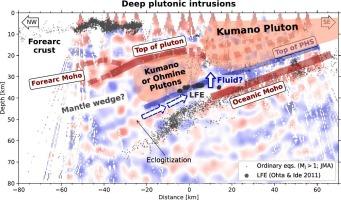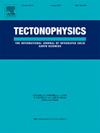从接收方格林函数揭示低频地震上方的深成岩体
IF 2.6
3区 地球科学
Q2 GEOCHEMISTRY & GEOPHYSICS
引用次数: 0
摘要
俯冲带的地震异质性提供了对慢速地震和潜在大地震的洞察力。对南海俯冲带纪伊半岛的研究表明,在俯冲板块上方的增生棱柱中存在高密度和高速度的柱状体,可能对特大推覆地震产生影响。异质性的横向变化和柱状体的空间范围仍有待深入研究。我们从广泛分布的活动地震观测资料中获得的接收方格林函数的被动源成像显示,在俯冲菲律宾海板块的顶面,所有沿倾角剖面都有一个尖锐的负S波速度对比,而在前弧地壳则有一个向上倾斜的正相位。弧前地壳的低渗透性阻止了板块脱水流体进一步渗入上地壳。在西部地区,我们也在前弧地壳中发现了向上倾斜的正相位。负相向慢震源的深部延伸。与此同时,正相位可能代表了熊野和大峰岩浆岩的顶面,一直延伸到板块界面。结合重力异常、板块内地震和地震层析成像的观测结果,我们的解释支持了在前弧地壳深处以及俯冲的 PHS 板块横向上存在着延伸的深成岩体,而不是蛇化的地幔楔。上层板块的渗透率一般较低,但在震源的上升侧可能存在局部渗透率较高的区域。在这种情况下,流体可以在局部向上渗透,这可能会使西部地区的慢地震相对不那么活跃。上盘岩性的横向变化可能会影响流体过程和缓震活动。本文章由计算机程序翻译,如有差异,请以英文原文为准。

Deep plutonic bodies over low-frequency earthquakes revealed from receiver-side Green's functions
Seismological heterogeneity in subduction zones provides insights into slow earthquakes and potential megathrust earthquakes. Studies at the Kii Peninsula in the Nankai subduction zone suggest that there are high-density and high-velocity plutonic bodies in the accretionary prism over the subducting slab, potentially influencing megathrust earthquakes. The lateral variation of heterogeneity and the spatial extent of plutonic bodies remain to be investigated well. Our passive-source imaging of receiver-side Green's functions, from widely distributed campaign seismic observations, reveals a sharp negative S-wave velocity contrast on the top surface of the subducting Philippine Sea plate common to all along-dip profiles and a positive phase tilted upward in the forearc crust. The low permeability of the forearc crust prevents the infiltration of slab-dehydrated fluid further into the upper crust. In the western area, we also found positive phases tilted upward in the forearc crust. The negative phase extends towards the deeper extent of slow-earthquake sources. Meanwhile, the positive phase likely represents the top surface of plutonic rocks of the Kumano and Ohmine plutons that span all the way down to the plate interface. Together with observations of gravity anomaly, intraslab seismicity, and seismic tomography, our interpretation supports the presence of plutonic bodies which extend deep beneath the forearc crust as well as laterally over the subducting PHS slab, rather than a serpentinized mantle wedge. The upper plate is generally low in permeability, but areas with localized high permeability may exist on the updip side of tremor sources. This condition, wherein fluid can infiltrate upwards locally, may maintain the relatively less active slow earthquakes in the western area. The lateral variation of the upper-plate lithology likely influences fluid processes and slow earthquake activities.
求助全文
通过发布文献求助,成功后即可免费获取论文全文。
去求助
来源期刊

Tectonophysics
地学-地球化学与地球物理
CiteScore
4.90
自引率
6.90%
发文量
300
审稿时长
6 months
期刊介绍:
The prime focus of Tectonophysics will be high-impact original research and reviews in the fields of kinematics, structure, composition, and dynamics of the solid arth at all scales. Tectonophysics particularly encourages submission of papers based on the integration of a multitude of geophysical, geological, geochemical, geodynamic, and geotectonic methods
 求助内容:
求助内容: 应助结果提醒方式:
应助结果提醒方式:


